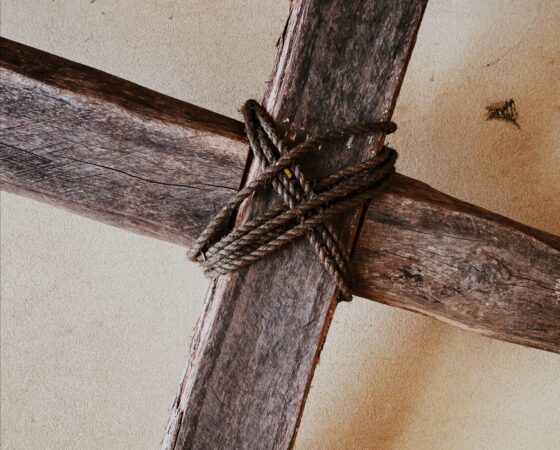Good Friday (Revised Common Lectionary) | 04.07.23 | John 19.17-30 | Carl A. Voges |
The Passage
Due to this passage’s length, it is not printed in full. Instead, the homily, based on the English Standard Version, was worked out on the basis of the passage’s five sections –
First Scene (vss 17-18): Jesus goes to Calvary
Second Scene (vss 19-22): Pilate / Royal Inscription
Third Scene (vss 23-24): Executioners divide Jesus’ Clothes; Seamless Tunic
Fourth Scene (vss 25-27): Jesus gives His Mother to Beloved Disciple
Fifth Scene (vss 28-30): Jesus’ Cry of Thirst; Executioners offer Him Wine; Jesus
hands over His Spirit
“Come, let us return to the Lord; for he has torn us, that he may heal us; he has struck us down, and he will bind us up.” [Hosea 6.1]
In the Name of Christ + Jesus Our Lord
The world has little idea of how nervy and startling it is for the Lord’s baptized people to be worshiping on the Day of the Son’s death! While most people recognize that death is the ultimate end of the world’s life, the world still believes it can push death around: ignoring it, laughing about it, delaying it with the latest advances in medical skills and equipment, triggering it on our own, and polishing a person’s life up after it has occurred (whether the commendations are real or not, whether they are deserved or not!).
Because the world thinks it can push death around, it also thinks it can decide what real life is. Thus, it asserts that such life begins, continues and ends with each individual person! That’s why, with such thinking and believing swirling around our lives, it is startling and nervy to the world for the Lord’s baptized people to worship him on the Day of Son’s death!
Further, as we plunge more deeply into this portion of Our Lord’s Passion, it is going to be clearer why this Day is called Good! There are five scenes from the Lord’s Passion which demonstrate the huge differences between death as the world deals with it and death as the LORD God deals with it.
First Scene (17-18): Jesus goes to Calvary
Verses 17-18 serve as a transition from the episodes where Jesus is judged by Pilate to the episodes that occur while Jesus is on the Cross.
What do we make of John’s statement that Jesus carried the Cross by himself? It continues the theme that Jesus went to his own death as the One who knew where his Life was going. Earlier in John’s Gospel, Jesus had said that he would lay down his Life and no one would take it from him.
He had instructed Judas at the First Eucharist to be quick about the business of betrayal! He showed that he could have resisted arrest by making his enemies fall to the ground in Gethsemane. He stood unafraid before Annas and Pilate. Jesus knew where his Life was going; that is why he is carrying the Cross by himself!
Second Scene (19-22): Pilate and Royal Inscription
In verses 19-22, as Jesus goes out to Calvary, recall that it was also called the “Place of the Skull.” Most likely it had that description because of the remnants of previous crucifixions. Still, it is intriguing to note the tradition which stated that Adam’s bones were buried there.
The antagonists in Jesus’ trial – the Jewish leaders and Pilate – continue their clashing over Jesus in this scene. Pilate has been weak with the leaders, but he will cower no more. The leaders forced him to turn Jesus over for crucifixion, but now he is going to have the last word.
The complaints of the Jewish leaders re-introduce the theme of kingship that was so prominent at the trial. John turns the charge of kingship into a world-wide proclamation through Pilate’s order for the inscription over the Cross (remember that Pilate represents the greatest political power at trial).
It is very striking that in the major languages of the time (Aramaic, Greek, Latin) the inscription proclaims that Our Lord’s kingship streams out from his ross. Running under this proclamation is the reality that, as Jesus is being lifted up from earth, he is drawing all people to himself!
Third Scene (23-24): Executioners Divide Jesus’ Clothes; Seamless Tunic
Verses 23-24 relate the division of Jesus’ clothes by his executioners. It is the fulfillment of Psalm 22.17, a verse heard yesterday at the end of the Maundy Thursday Liturgy.
The seamless tunic may be reminder of the clothing of the high priest, suggesting that Our Lord died not only as the King, but also as the Priest. This suggestion is displayed in a number of New Testament passages, including those from the Letter to the Hebrews. The seamless tunic may also suggest, if it is not leaned on too heavily – the unity of the one, holy, catholic and apostolic Church.
Fourth Scene (25-27): Jesus Gives His Mother to Beloved Disciple
In verses 25-27, Jesus makes two powerful comments – “Woman, here is your son” and “Here is your mother!” There are two scenes in John’s Gospel where his mother, Mary, appears. At Cana her intervention was rejected because the Hour had not yet come; at the Cross we are in that Hour.
Mary, in becoming the mother of the Beloved Disciple (John), reaches back to the Old Testament themes of Eve and her children as well as Lady Zion giving birth to the new people in the Messianic Age.
Mary, in becoming the mother of the Beloved Disciple, also reaches forward to the New Testament reality of the Church. The Church gives birth to children through Baptism, bringing them up after Our Lord and surrounding them with deep, loving care.
The Beloved Disciple, in becoming a son of Mary, reaches backward and forward to every person in the world who has been drawn, who is being drawn and who will be drawn into the Lord’s Life. In this scene, Jesus is completing the work the Father gave him to do. He is providing for the future of those who believe in him. Jesus is giving those persons the love (the agape) of the Holy Trinity in which they shall live after he returns to the Father.
Fifth Scene (28-30): Jesus’ Cry of Thirst; Executioners Offer Him Wine; Jesus
Hands over His Spirit
The verses in this concluding scene (28-30) focus on Jesus’ cry of thirst, the offering of wine by the executioners and the handing over of his Spirit.
Is Jesus’ thirst to be understood only as a dryness and his desire to be more comfortable? Or is it connected with the Cup that Father gave him to drink? The Cup was one of suffering and death, one foaming with the wrath of the LORD God. Only when Jesus has tasted the bitter wine of death will his Father’s intentions be fulfilled. Finishing his work now, Jesus thirsts to drink that Cup to last drop! In his thirst and response to the Hour, Jesus fulfills the Old Testament psalms (69.23 and 22.15) that had predicted his death.
What is the meaning of hyssop? In the book of Exodus it was specified that hyssop (a stick or reed) was used to sprinkle the blood of the Passover lamb on the doorposts of the Israelite homes. This blood protected them from the angel of death which swarmed over Egypt that night when the Exodus got underway.
In John’s Gospel, Jesus is sentenced to death at the actual hour when the slaughter of the Passover lambs begins in the temple precincts. John is helping us to see Jesus’ dying as the Passover lamb is the fulfillment of the Father’s promise – Jesus dies as the Lamb of God who takes away the world’s sin.
His final words – “It is finished!” – are victorious; our Lord is obediently fulfilling his Father’s will. Thus, Jesus accepts the swallow of sour wine, he bows his head, gives up his Spirit and the Hour thunders to its conclusion!
Every day in the course of every week gives us solid evidence of how the world deals with death. This Day (the one we call Good!) gives us fuller evidence of how the LORD God deals with it. Through these five scenes from John’s Passion account we now better understand how nervy and startling it is for the Lord’s baptized people to worship him on the Day of Son’s death1
The Son’s dying on the Cross is not a tragedy which could have been prevented or an event which leaves us crying over its unfairness (don’t we recognize how sin-soaked and sin-driven the world’s life is?). Neither does the Son’s dying on the Cross leave us with empty promises that we are going to conduct ourselves better (do we honestly think we, and we alone, can bring our lives to the point where they will reflect less sin?).
While the world thinks it can push death around: ignoring it, laughing about it, delaying it, triggering it or polishing up a life struck down by it, Our Lord succumbs to death and, as he does, he crushes its power and its hold on the world’s people. Thus, our gathering to worship the Father, Son and Holy Spirit on the Day of the Son’s death is more than startling and nervy, it is an actual plunge into the salvation which erupts from that dying!
Now may the peace of the LORD God, which is beyond all understanding, keep our hearts and minds through Christ + Jesus Our Lord
Pr. Carl A. Voges, Columbia, SC; carl.voges4@icloud.com

